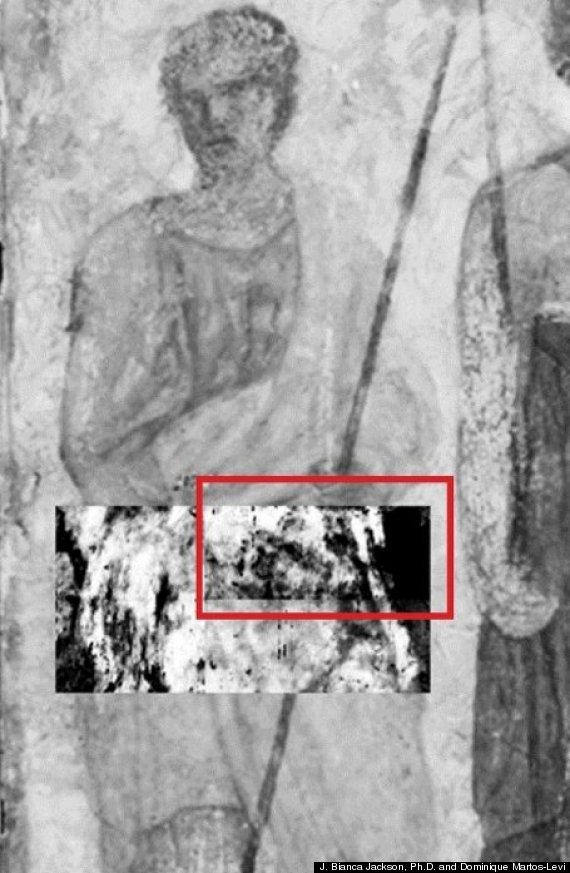Art Restoration
Framing your mirrors
by Sierra Sparks on 06/25/15
Ok, so we do much more than just Art Restoration... We happen to be experts in framing as well. I absolutely LOVE this idea and am going to try it myself very soon (yes, I will post pictures...).
Here is the before... boring bathroom mirror

But wait, easy DIY ("ish") way to class up your bathroom! You can order frames from us to size and put them up (again, be trying this myself soon). Here is the after:

Easy as that!!! What a difference!!
X Ray for Paintings - Art Restoration
by Sierra Sparks on 04/20/13
What lies beneath the layers of famous paintings? Apparently...more paintings.
Researchers recently discovered such a conundrum at the Louvre Museum in Paris. They used a TSA-style scanner to unveil a mysterious image hidden under the brushstrokes of the famous mural ”Trois Hommes Armés de Lances."
In fact, the scanner -- just like those used in airport security for full-body scans -- looked beneath the surface of the mural without causing damage. What was found? A Roman man's face.
"We were amazed, and we were delighted," lead researcher Dr. J. Bianca Jackson, who is now a postdoctoral researcher at University of Rochester, said in a written statement. "We could not believe our eyes as the image materialized on the screen ... With a little extra manipulation with contrast and color, the facial features came through like a miracle."
 Terahertz rays unveil for the first time a hidden image (red box) of a man’s face under the surface of a famous fresco, or mural, in Paris’ Louvre Museum.
Terahertz rays unveil for the first time a hidden image (red box) of a man’s face under the surface of a famous fresco, or mural, in Paris’ Louvre Museum.
Jackson and her team actually attempted several other techniques to "see" beneath the layers of the mural: X-ray radiography, x-ray fluorescence imaging, infrared photography, infrared reflectometry and UV florescence. They came up with nothing.
"We measured about ten different sections and there was a lot of data to process," Jackson told The Huffington Post. "We weren't seeing anything for the first seven or eight sections, so we were resigning ourselves to having the same results as the x-ray and infrared images."
The process is slow -- it takes hours to analyze a section the size of a sheet of paper -- but little by little, the image of a man's face and part of his tunic appeared on the screen. No word yet, however, on who this mystery man really was.
The piece itself is of 19th Century art collector Giampietro Campana, who was known for "reworking" his works (and the Campana collection has a scandalous history of recycled paintings). But the finding is likely part of an ancient Roman fresco, and is believed to be thousands of years old.
"This particular experiment was exciting for us because it was the first hidden painting we've imaged that was figurative, instead of a decorative or geometric design," Jackson said.
The finding was presented this week at the 245th national meeting of the American Chemical Society.v
Art Restoration in the News
by Sierra Sparks on 03/07/12
Bank of America Merrill Lynch will fund the restoration of five Tel Aviv Museum of Art paintings byMarc Chagall, who was deeply involved in the Israeli institution’s establishment.
The paintings are “Musician with the Red Beard” (1919);“Jew with Torah” (1925); “Lovers” (1929); “The Wailing Wall”(1932); and “Solitude” (1993), three of which were donated by Chagall to the museum.
“We believe that understanding cultures through the arts is an important foundation for promoting innovation and tolerance in an increasingly integrated world,” Rena DeSisto, global arts and culture executive at Bank of America, said in a statement e-mailed today.
The North Carolina-based bank’s restoration project provides grants to museums around the world to conserve significant works of art that are in danger of degeneration, the lender’s website said.
“In these economically challenged times, and as art conservation consumes ever greater portions of tightened museum budgets, the need for private arts funding has become even more critical,” Yoram Inbar, country executive at Merrill Lynch Israel, said in the release. The statement did not specify how much money was donated.
In the News: Art Restoration
by Sierra Sparks on 03/06/12
Hi everyone, It's been so interesting to me how art restoration has been in the news more and more lately. Paintings celebrated artist Sobha Singh have been withering away in a Himachal Pradesh gallery. But it has caught the attention of international experts who are coming to the Sobha Singh Museum in Andretta village near Palampur in Kangra Valley later this month to restore and preserve them.
Two art restorers from Britain will be visiting the museum to critically inspect and restore some of the works, Hriday Paul Singh, general secretary of the Sobha Singh Memorial Art Society and in-charge of the museum, told IANS.
Ian Barrand, a restorer who works at a prestigious museum in Yorkshire, and artist Bhajan Hunjan would assess and advice on what needs to be put in place for future longevity of Sobha Singh`s lifetime works, he added.
According to him, some cracks have appeared in six works which include the portraits of the late Amrita Pritam, a Gorkha soldier, paintings of Guru Teg Bahadur - the ninth Sikh guru, and Lord Krishna.
Museum caretakers attributed high rainfall in the region for damage to the artefacts. "Excessive moisture and exposure to dust ate damaging the paintings," a caretaker said. -----> On a side note: Be very careful with water and moisture. Even in places you would think are ok. we see more wate damage that you could imagine and is one of the most difficult issues to deal with because you are not only dealing with warping, but usually mold and mildew as well. All of this can be treated and mended with careful cleaning, conservation and restoration.



